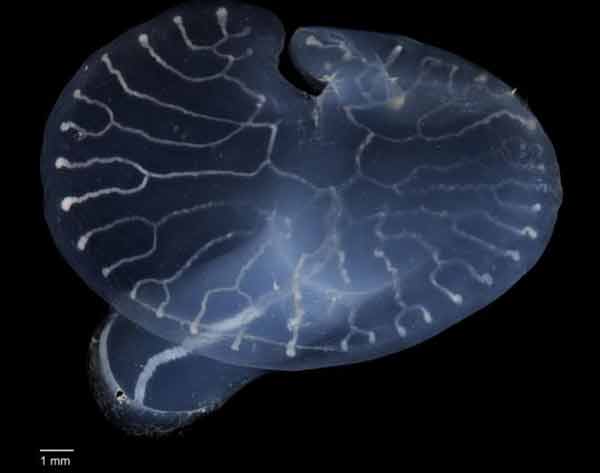
Melbourne, Australia (BBN)-Australian scientists have used genetic material to pinpoint the origin of the deep-sea mushroom, an unusual gelatinous creature first dredged up near Tasmania in 1986.
The organisms have a cylindrical stalk capped by a flat, semi-transparent disc that houses visible channels branching outwards, reports BBC.
These channels, which resemble tree-like diagrams known as dendrograms, are the basis for its scientific name - Dendrogramma.
The original specimens were described for the first time in 2014 by a team of Danish scientists, one of whom had been aboard the 1986 voyage and later transported the samples to Copenhagen.
The Danish team classified the creatures as belonging to their own unique taxonomic group in a paper published in the journal PLOS One.
Genetic puzzle
But the researchers were unable to support the claim with genetic evidence, due to the way the specimens had been preserved.
"Like forensics and in medicine, DNA has become an essential part of a modern zoologists' toolkit," says Dr Tim O'Hara, a senior curator at Museum Victoria in Melbourne.
"Publishing a new phylum without actually showing how it was related to other animals through DNA was a very old-fashioned way of doing things.
"They copped a bit of flack, but there the matter rested."
But in late 2015, after nearly 30 years without a reported sighting, the strange mushroom-shaped creatures were relocated by scientists aboard the Australian research vessel Investigator.
"It was a 'eureka' moment," says Hugh MacIntosh, a senior research fellow at Museum Victoria who identified the creatures.
"Holding one up to the light, the distinctive forked veins shimmered through the transparent body, and it suddenly dawned upon me that we had rediscovered the elusive Dendrogramma."
In total, 85 specimens were collected from a depth of around 3km on the continental slope near South Australia.
They were stored in a solution that would enable DNA extraction.
"We could suddenly get DNA and complete the picture, which is what we've done," says Dr O'Hara, who led the genetic component of the research.
Modular jellyfish
The results of the team's analysis, published this week in the journal Current Biology, have revealed that the deep-sea creatures are not unique in the animal kingdom.
Instead, they belong to a class of floating jellyfish known as siphonophores, found along the Australian coast, and in the Indian and Pacific Oceans.
The Portuguese man-of-war jellyfish, also known as a bluebottle, is considered part of the siphonophore class.
"We were totally surprised," says Dr O'Hara.
"We only vaguely knew what a siphonophore was because they don't turn up very often."
Although they appear to be one organism, siphonophores are actually comprised of many polyps, which are specialised for buoyancy, propulsion, gathering and eating food, reproducing, and fending off threats, explains O'Hara.
They also have a mushroom-shaped organ called a bract, which can become detached from the rest of the animal when it's disturbed.
O'Hara says the deep-sea mushroom is not an independent species, as was previously suggested, but a bract, which has been shed by a larger organism, and which lives for only a very short time afterwards.
"We were a little bit disappointed," he says.
"It would have been nice to find a new phylum [or class of animal], but nonetheless we solved the mystery."
Ocean's mysteries
But with one mystery solved, another has immediately opened - with a diameter of 2cm, the mushroom-shaped caps are considerably larger than all the bract appendages of all known siphonophores.
"We know it's part of something. But what our actual animal looks like in real life is still a mystery," he says.
The team's findings reveal how little we know about the deep ocean.
With no deep-sea submarines, he says Australia still has to "rely on old-fashioned dredges and sleds, which get dangled all the way to the sea floor, pulled along for a few metres, and then hauled back up again.
"It's all exactly the same as it was in 1870, really. So we're still groping in the dark when it comes to deep-sea research."
BBN/SK/AD